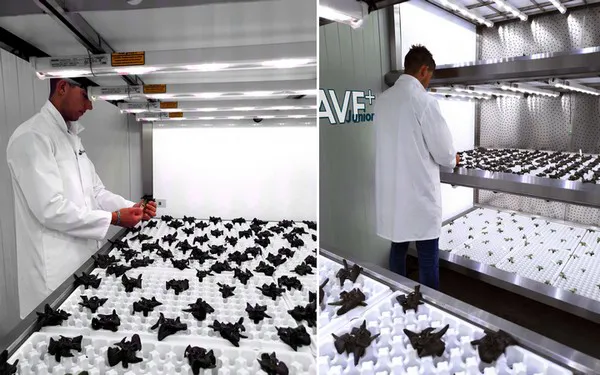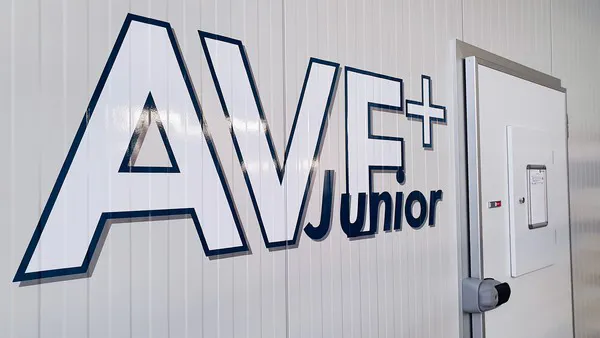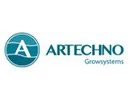"Together with another colleague, I am adding green thumbs to the team that is full of technicians here", Rick van Schie laughs. As the son of a tomato grower and next year's fourth-year horticulture student, he started cultivation research in the industrial hall of Artechno in De Lier. In a AVF+ Junior climate chamber Rick researches irrigation strategies for four different substrates and the effect that far-red light has on the stretching in lettuce.
Previously, the Artechno industrial hall was mainly the place to build complete water management systems for the greenhouse or harvesting lines and turnkey systems for vertical farms and deep-float systems. “The cultivation space with deep-float facility provided insight into growth and also important key figures for the business case. By testing and growing ourselves, we can now also better serve our customers in the vertical farm industry and provide them with better data and growth recipes.”
Rick started growing in the climate chamber in mid-June. "It is often wise for a grower to first do tests in a small chamber and to collect as much information as possible about lighting, climate and irrigation before scaling up to a larger system. That is why we also offer our chambers for rent to growers."

Cameras and LED
The AVF + Junior with which Rick is currently doing tests, is equipped with Philips GEN3 LED luminaires, whereby both the spectrum and the light intensity are adjustable. The chamber is also equipped with special hyper-spectral cameras (and sensors), making it possible to monitor the crop and climate without having to enter the chamber.
Homogeneous climate
Anyone who would enter the chamber will notice, according to Rick, that the climate is remarkably homogeneous. "Or actually you do not notice that much and that is positive. To demonstrate that there really is air circulation, I have hung up an A4 sheet, but you do not notice it."
Art, general director: "The aim was to realize a delta T difference of less than 1 degree Celsius difference in a 10-layer climate chamber of about 8 meters high, and we succeeded."
All this is possible thanks to the air treatment units that were developed by Artechno itself. "You want to exclude as many variables as possible in your research, so a homogeneous climate is essential."
Study 1: irrigation strategies
The first study examines the effect of different irrigation strategies on four different substrates (stone wool, foam plug, glue plug and soil mix with 10% wood fiber). This should become the basis for other studies with various types of lettuce, Rick says.
Study 2: far-red light
The second research is conducted into the addition of far-red light. Lighting is applied with 180 micromoles for a total of 18 hours and in the last hour far-red light is added with 10%. There is also a control group (DRB LB) without the addition of far-red light.
"The purpose of the addition of far-red light is to achieve more stretching in the leaves, so that the plant makes better use of the growing surface after transplanting. This could possibly also influence the bringing forward of the growth curve."
Germination
Rick is very satisfied with the results of the sowing tests in comparison to the tests carried out in the previous two years. "96-98% germination on the various substrates is a good result, but maybe this might be surpassed by an upcoming germination chamber."
Low input, high output
The results of the tests are assessed, among other things, by measurements of fresh and dry weight, growth percentage, quality and kilo/m2. "From these results, certain trend lines are emerging, from which the crop growth rate can be calculated. This trend line also gives us insight into the smarter use of the LED light (grams of fresh weight per mole). The ultimate aim is to be consistent with the lowest possible input to achieve the highest output (kilo/m2/year)."
Rick knows that kg/m2/year is an important factor for customers to determine the profitability of their business case. "The results of our tests are used for this, among other things. The results and experiences with certain products we always provide feedback to our suppliers and customers, so that they remain up-to-date."

Soft fruit
Meanwhile, Rick and Artechno see that, in addition to demand for research for herbs and leafy crops, there is also an increasing demand for soft fruit. "This includes, for example, growing strawberries indoors and testing with the rooting phase in, for example, the propagation of blueberry plants.
We also want to be proactive in this, so we will certainly carry out tests ourselves. For ourselves, but also for growers or suppliers to whom we rent the chambers. In addition, I can mentor them and, in consultation, help to draw up a good research plan, always with a lot of literature as a foundation, so that you are not wasting time doing research that has already been done."
For more information:
Artechno
www.artechno.nl
info@artechno.nl
Rick van Schie
rick@artechno.nl
